University Civil Engineering Report: Construction Methods and Analysis
VerifiedAdded on 2021/04/21
|27
|11617
|104
Report
AI Summary
This report provides a detailed analysis of various construction methods employed in civil engineering projects. It covers tunneling methods like cut and cover, drill and blast, and bored tunneling, along with their applications in Hong Kong's infrastructure. The report also explores construction methods for hydraulic structures, marine works (including caissons and suction dredgers), and highway and railway works. Furthermore, it addresses slope stabilization techniques and includes a resource plan for a civil engineering activity. The report incorporates figures and references to support the discussion of construction methods and their suitability for different applications.
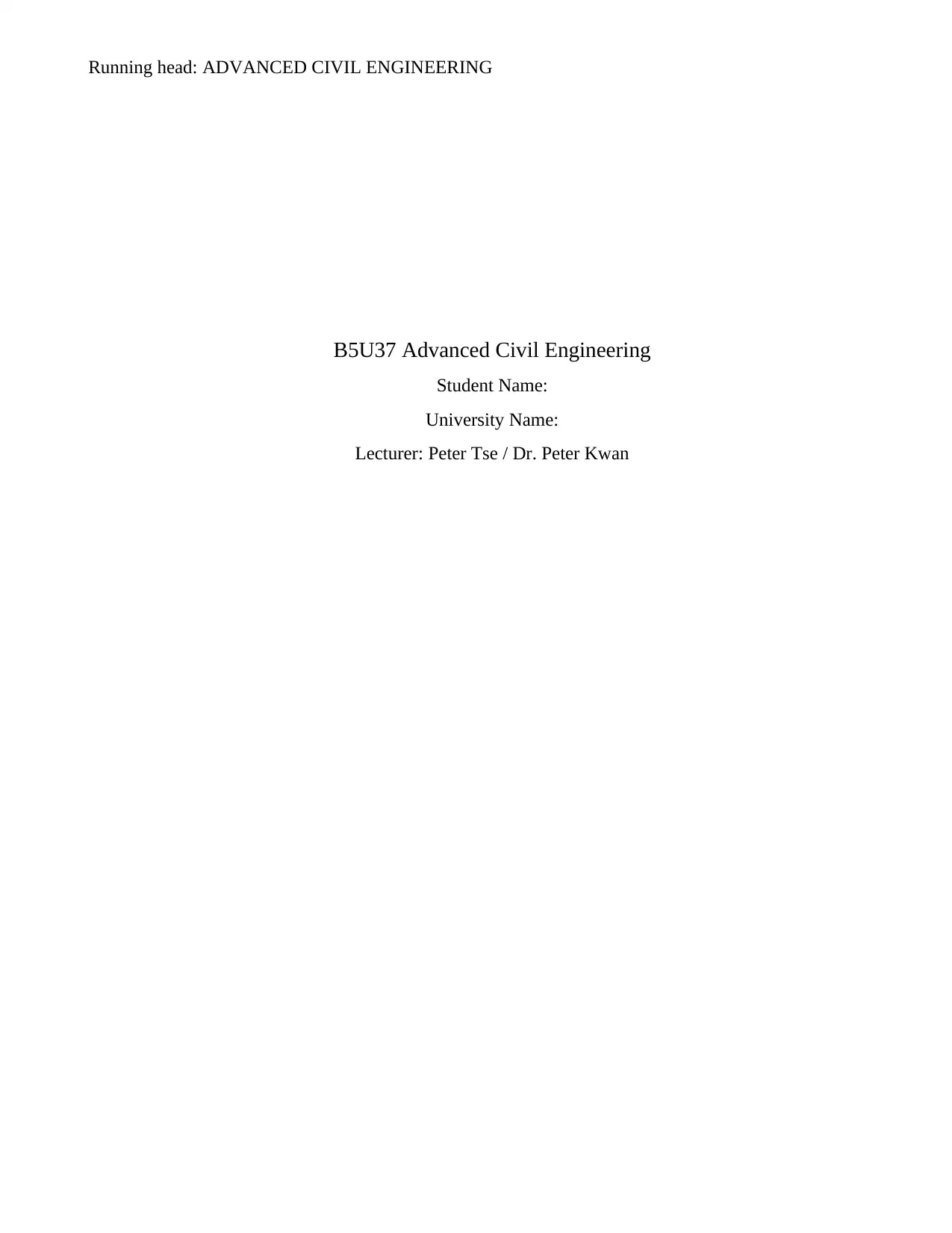
Running head: ADVANCED CIVIL ENGINEERING
B5U37 Advanced Civil Engineering
Student Name:
University Name:
Lecturer: Peter Tse / Dr. Peter Kwan
B5U37 Advanced Civil Engineering
Student Name:
University Name:
Lecturer: Peter Tse / Dr. Peter Kwan
Paraphrase This Document
Need a fresh take? Get an instant paraphrase of this document with our AI Paraphraser
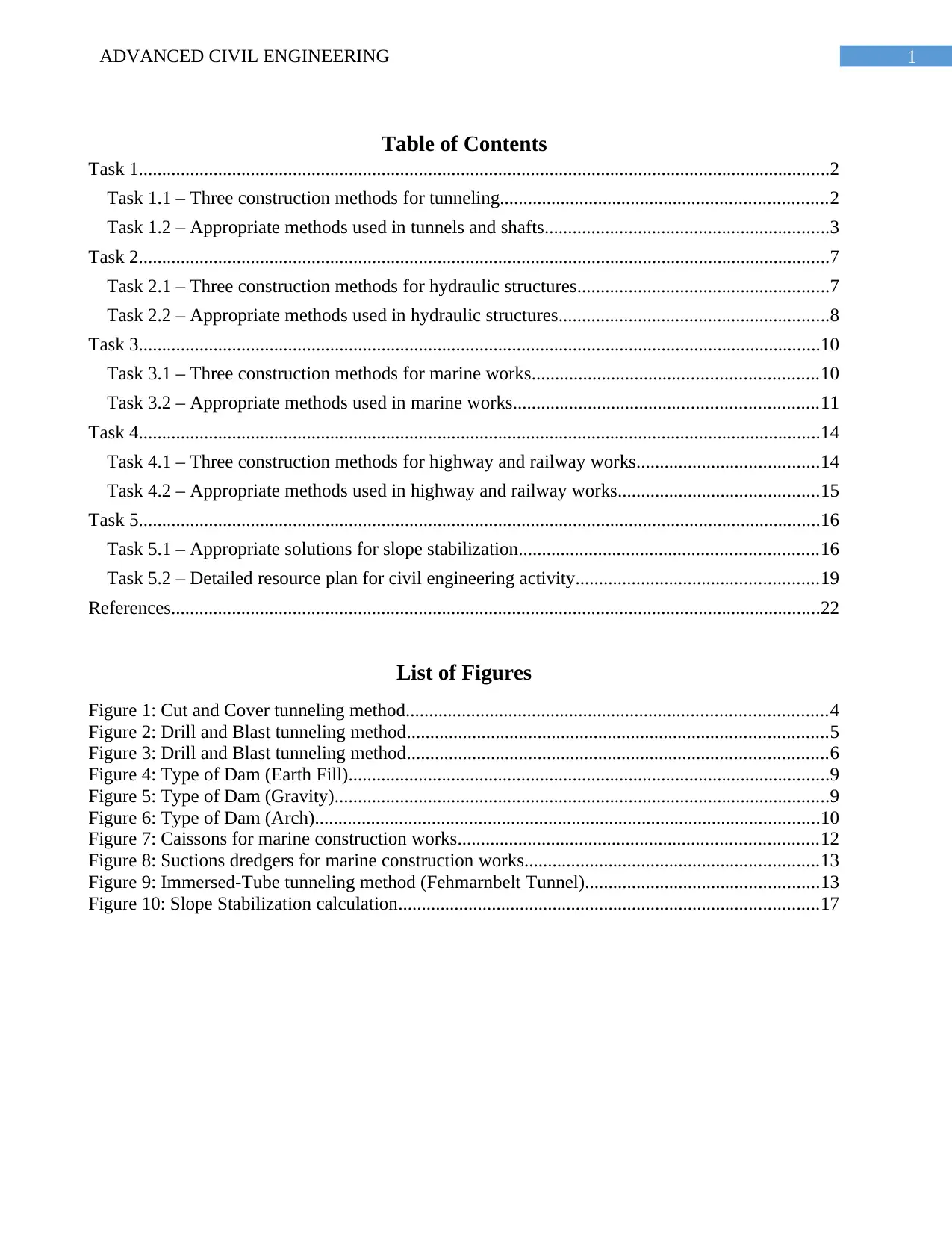
1ADVANCED CIVIL ENGINEERING
Table of Contents
Task 1....................................................................................................................................................2
Task 1.1 – Three construction methods for tunneling......................................................................2
Task 1.2 – Appropriate methods used in tunnels and shafts.............................................................3
Task 2....................................................................................................................................................7
Task 2.1 – Three construction methods for hydraulic structures......................................................7
Task 2.2 – Appropriate methods used in hydraulic structures..........................................................8
Task 3..................................................................................................................................................10
Task 3.1 – Three construction methods for marine works.............................................................10
Task 3.2 – Appropriate methods used in marine works.................................................................11
Task 4..................................................................................................................................................14
Task 4.1 – Three construction methods for highway and railway works.......................................14
Task 4.2 – Appropriate methods used in highway and railway works...........................................15
Task 5..................................................................................................................................................16
Task 5.1 – Appropriate solutions for slope stabilization................................................................16
Task 5.2 – Detailed resource plan for civil engineering activity....................................................19
References...........................................................................................................................................22
List of Figures
Figure 1: Cut and Cover tunneling method..........................................................................................4
Figure 2: Drill and Blast tunneling method..........................................................................................5
Figure 3: Drill and Blast tunneling method..........................................................................................6
Figure 4: Type of Dam (Earth Fill).......................................................................................................9
Figure 5: Type of Dam (Gravity)..........................................................................................................9
Figure 6: Type of Dam (Arch)............................................................................................................10
Figure 7: Caissons for marine construction works.............................................................................12
Figure 8: Suctions dredgers for marine construction works...............................................................13
Figure 9: Immersed-Tube tunneling method (Fehmarnbelt Tunnel)..................................................13
Figure 10: Slope Stabilization calculation..........................................................................................17
Table of Contents
Task 1....................................................................................................................................................2
Task 1.1 – Three construction methods for tunneling......................................................................2
Task 1.2 – Appropriate methods used in tunnels and shafts.............................................................3
Task 2....................................................................................................................................................7
Task 2.1 – Three construction methods for hydraulic structures......................................................7
Task 2.2 – Appropriate methods used in hydraulic structures..........................................................8
Task 3..................................................................................................................................................10
Task 3.1 – Three construction methods for marine works.............................................................10
Task 3.2 – Appropriate methods used in marine works.................................................................11
Task 4..................................................................................................................................................14
Task 4.1 – Three construction methods for highway and railway works.......................................14
Task 4.2 – Appropriate methods used in highway and railway works...........................................15
Task 5..................................................................................................................................................16
Task 5.1 – Appropriate solutions for slope stabilization................................................................16
Task 5.2 – Detailed resource plan for civil engineering activity....................................................19
References...........................................................................................................................................22
List of Figures
Figure 1: Cut and Cover tunneling method..........................................................................................4
Figure 2: Drill and Blast tunneling method..........................................................................................5
Figure 3: Drill and Blast tunneling method..........................................................................................6
Figure 4: Type of Dam (Earth Fill).......................................................................................................9
Figure 5: Type of Dam (Gravity)..........................................................................................................9
Figure 6: Type of Dam (Arch)............................................................................................................10
Figure 7: Caissons for marine construction works.............................................................................12
Figure 8: Suctions dredgers for marine construction works...............................................................13
Figure 9: Immersed-Tube tunneling method (Fehmarnbelt Tunnel)..................................................13
Figure 10: Slope Stabilization calculation..........................................................................................17
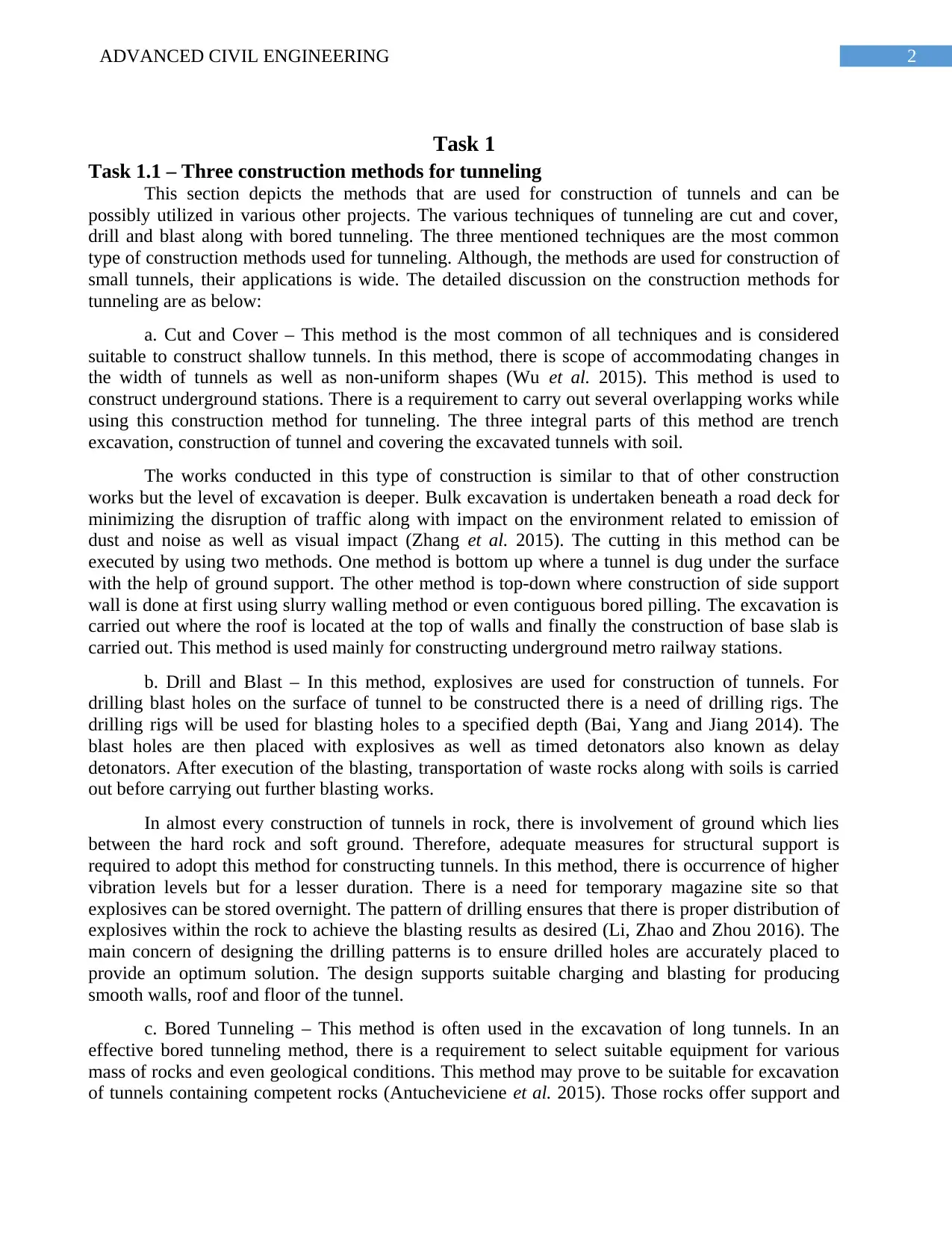
2ADVANCED CIVIL ENGINEERING
Task 1
Task 1.1 – Three construction methods for tunneling
This section depicts the methods that are used for construction of tunnels and can be
possibly utilized in various other projects. The various techniques of tunneling are cut and cover,
drill and blast along with bored tunneling. The three mentioned techniques are the most common
type of construction methods used for tunneling. Although, the methods are used for construction of
small tunnels, their applications is wide. The detailed discussion on the construction methods for
tunneling are as below:
a. Cut and Cover – This method is the most common of all techniques and is considered
suitable to construct shallow tunnels. In this method, there is scope of accommodating changes in
the width of tunnels as well as non-uniform shapes (Wu et al. 2015). This method is used to
construct underground stations. There is a requirement to carry out several overlapping works while
using this construction method for tunneling. The three integral parts of this method are trench
excavation, construction of tunnel and covering the excavated tunnels with soil.
The works conducted in this type of construction is similar to that of other construction
works but the level of excavation is deeper. Bulk excavation is undertaken beneath a road deck for
minimizing the disruption of traffic along with impact on the environment related to emission of
dust and noise as well as visual impact (Zhang et al. 2015). The cutting in this method can be
executed by using two methods. One method is bottom up where a tunnel is dug under the surface
with the help of ground support. The other method is top-down where construction of side support
wall is done at first using slurry walling method or even contiguous bored pilling. The excavation is
carried out where the roof is located at the top of walls and finally the construction of base slab is
carried out. This method is used mainly for constructing underground metro railway stations.
b. Drill and Blast – In this method, explosives are used for construction of tunnels. For
drilling blast holes on the surface of tunnel to be constructed there is a need of drilling rigs. The
drilling rigs will be used for blasting holes to a specified depth (Bai, Yang and Jiang 2014). The
blast holes are then placed with explosives as well as timed detonators also known as delay
detonators. After execution of the blasting, transportation of waste rocks along with soils is carried
out before carrying out further blasting works.
In almost every construction of tunnels in rock, there is involvement of ground which lies
between the hard rock and soft ground. Therefore, adequate measures for structural support is
required to adopt this method for constructing tunnels. In this method, there is occurrence of higher
vibration levels but for a lesser duration. There is a need for temporary magazine site so that
explosives can be stored overnight. The pattern of drilling ensures that there is proper distribution of
explosives within the rock to achieve the blasting results as desired (Li, Zhao and Zhou 2016). The
main concern of designing the drilling patterns is to ensure drilled holes are accurately placed to
provide an optimum solution. The design supports suitable charging and blasting for producing
smooth walls, roof and floor of the tunnel.
c. Bored Tunneling – This method is often used in the excavation of long tunnels. In an
effective bored tunneling method, there is a requirement to select suitable equipment for various
mass of rocks and even geological conditions. This method may prove to be suitable for excavation
of tunnels containing competent rocks (Antucheviciene et al. 2015). Those rocks offer support and
Task 1
Task 1.1 – Three construction methods for tunneling
This section depicts the methods that are used for construction of tunnels and can be
possibly utilized in various other projects. The various techniques of tunneling are cut and cover,
drill and blast along with bored tunneling. The three mentioned techniques are the most common
type of construction methods used for tunneling. Although, the methods are used for construction of
small tunnels, their applications is wide. The detailed discussion on the construction methods for
tunneling are as below:
a. Cut and Cover – This method is the most common of all techniques and is considered
suitable to construct shallow tunnels. In this method, there is scope of accommodating changes in
the width of tunnels as well as non-uniform shapes (Wu et al. 2015). This method is used to
construct underground stations. There is a requirement to carry out several overlapping works while
using this construction method for tunneling. The three integral parts of this method are trench
excavation, construction of tunnel and covering the excavated tunnels with soil.
The works conducted in this type of construction is similar to that of other construction
works but the level of excavation is deeper. Bulk excavation is undertaken beneath a road deck for
minimizing the disruption of traffic along with impact on the environment related to emission of
dust and noise as well as visual impact (Zhang et al. 2015). The cutting in this method can be
executed by using two methods. One method is bottom up where a tunnel is dug under the surface
with the help of ground support. The other method is top-down where construction of side support
wall is done at first using slurry walling method or even contiguous bored pilling. The excavation is
carried out where the roof is located at the top of walls and finally the construction of base slab is
carried out. This method is used mainly for constructing underground metro railway stations.
b. Drill and Blast – In this method, explosives are used for construction of tunnels. For
drilling blast holes on the surface of tunnel to be constructed there is a need of drilling rigs. The
drilling rigs will be used for blasting holes to a specified depth (Bai, Yang and Jiang 2014). The
blast holes are then placed with explosives as well as timed detonators also known as delay
detonators. After execution of the blasting, transportation of waste rocks along with soils is carried
out before carrying out further blasting works.
In almost every construction of tunnels in rock, there is involvement of ground which lies
between the hard rock and soft ground. Therefore, adequate measures for structural support is
required to adopt this method for constructing tunnels. In this method, there is occurrence of higher
vibration levels but for a lesser duration. There is a need for temporary magazine site so that
explosives can be stored overnight. The pattern of drilling ensures that there is proper distribution of
explosives within the rock to achieve the blasting results as desired (Li, Zhao and Zhou 2016). The
main concern of designing the drilling patterns is to ensure drilled holes are accurately placed to
provide an optimum solution. The design supports suitable charging and blasting for producing
smooth walls, roof and floor of the tunnel.
c. Bored Tunneling – This method is often used in the excavation of long tunnels. In an
effective bored tunneling method, there is a requirement to select suitable equipment for various
mass of rocks and even geological conditions. This method may prove to be suitable for excavation
of tunnels containing competent rocks (Antucheviciene et al. 2015). Those rocks offer support and
⊘ This is a preview!⊘
Do you want full access?
Subscribe today to unlock all pages.

Trusted by 1+ million students worldwide
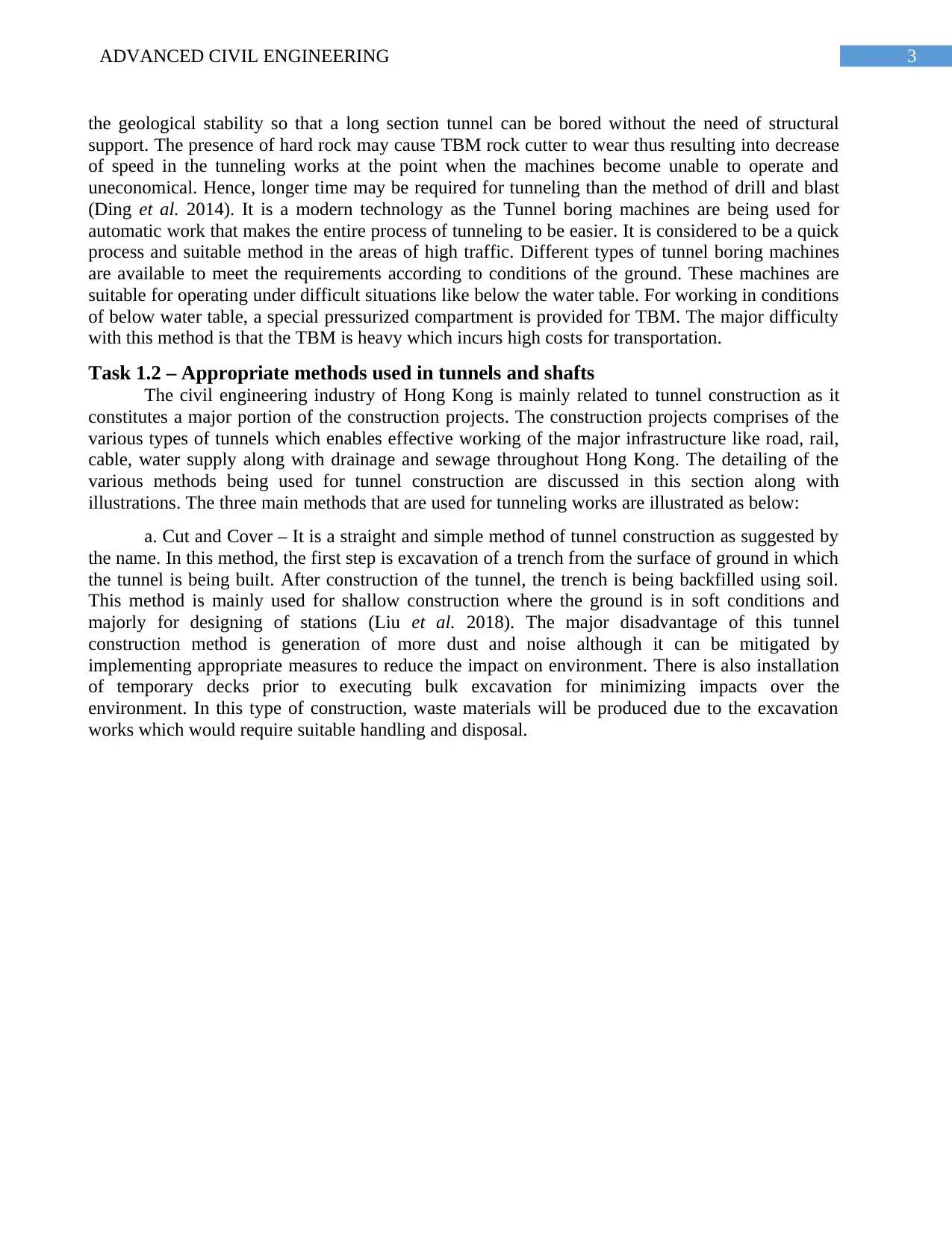
3ADVANCED CIVIL ENGINEERING
the geological stability so that a long section tunnel can be bored without the need of structural
support. The presence of hard rock may cause TBM rock cutter to wear thus resulting into decrease
of speed in the tunneling works at the point when the machines become unable to operate and
uneconomical. Hence, longer time may be required for tunneling than the method of drill and blast
(Ding et al. 2014). It is a modern technology as the Tunnel boring machines are being used for
automatic work that makes the entire process of tunneling to be easier. It is considered to be a quick
process and suitable method in the areas of high traffic. Different types of tunnel boring machines
are available to meet the requirements according to conditions of the ground. These machines are
suitable for operating under difficult situations like below the water table. For working in conditions
of below water table, a special pressurized compartment is provided for TBM. The major difficulty
with this method is that the TBM is heavy which incurs high costs for transportation.
Task 1.2 – Appropriate methods used in tunnels and shafts
The civil engineering industry of Hong Kong is mainly related to tunnel construction as it
constitutes a major portion of the construction projects. The construction projects comprises of the
various types of tunnels which enables effective working of the major infrastructure like road, rail,
cable, water supply along with drainage and sewage throughout Hong Kong. The detailing of the
various methods being used for tunnel construction are discussed in this section along with
illustrations. The three main methods that are used for tunneling works are illustrated as below:
a. Cut and Cover – It is a straight and simple method of tunnel construction as suggested by
the name. In this method, the first step is excavation of a trench from the surface of ground in which
the tunnel is being built. After construction of the tunnel, the trench is being backfilled using soil.
This method is mainly used for shallow construction where the ground is in soft conditions and
majorly for designing of stations (Liu et al. 2018). The major disadvantage of this tunnel
construction method is generation of more dust and noise although it can be mitigated by
implementing appropriate measures to reduce the impact on environment. There is also installation
of temporary decks prior to executing bulk excavation for minimizing impacts over the
environment. In this type of construction, waste materials will be produced due to the excavation
works which would require suitable handling and disposal.
the geological stability so that a long section tunnel can be bored without the need of structural
support. The presence of hard rock may cause TBM rock cutter to wear thus resulting into decrease
of speed in the tunneling works at the point when the machines become unable to operate and
uneconomical. Hence, longer time may be required for tunneling than the method of drill and blast
(Ding et al. 2014). It is a modern technology as the Tunnel boring machines are being used for
automatic work that makes the entire process of tunneling to be easier. It is considered to be a quick
process and suitable method in the areas of high traffic. Different types of tunnel boring machines
are available to meet the requirements according to conditions of the ground. These machines are
suitable for operating under difficult situations like below the water table. For working in conditions
of below water table, a special pressurized compartment is provided for TBM. The major difficulty
with this method is that the TBM is heavy which incurs high costs for transportation.
Task 1.2 – Appropriate methods used in tunnels and shafts
The civil engineering industry of Hong Kong is mainly related to tunnel construction as it
constitutes a major portion of the construction projects. The construction projects comprises of the
various types of tunnels which enables effective working of the major infrastructure like road, rail,
cable, water supply along with drainage and sewage throughout Hong Kong. The detailing of the
various methods being used for tunnel construction are discussed in this section along with
illustrations. The three main methods that are used for tunneling works are illustrated as below:
a. Cut and Cover – It is a straight and simple method of tunnel construction as suggested by
the name. In this method, the first step is excavation of a trench from the surface of ground in which
the tunnel is being built. After construction of the tunnel, the trench is being backfilled using soil.
This method is mainly used for shallow construction where the ground is in soft conditions and
majorly for designing of stations (Liu et al. 2018). The major disadvantage of this tunnel
construction method is generation of more dust and noise although it can be mitigated by
implementing appropriate measures to reduce the impact on environment. There is also installation
of temporary decks prior to executing bulk excavation for minimizing impacts over the
environment. In this type of construction, waste materials will be produced due to the excavation
works which would require suitable handling and disposal.
Paraphrase This Document
Need a fresh take? Get an instant paraphrase of this document with our AI Paraphraser
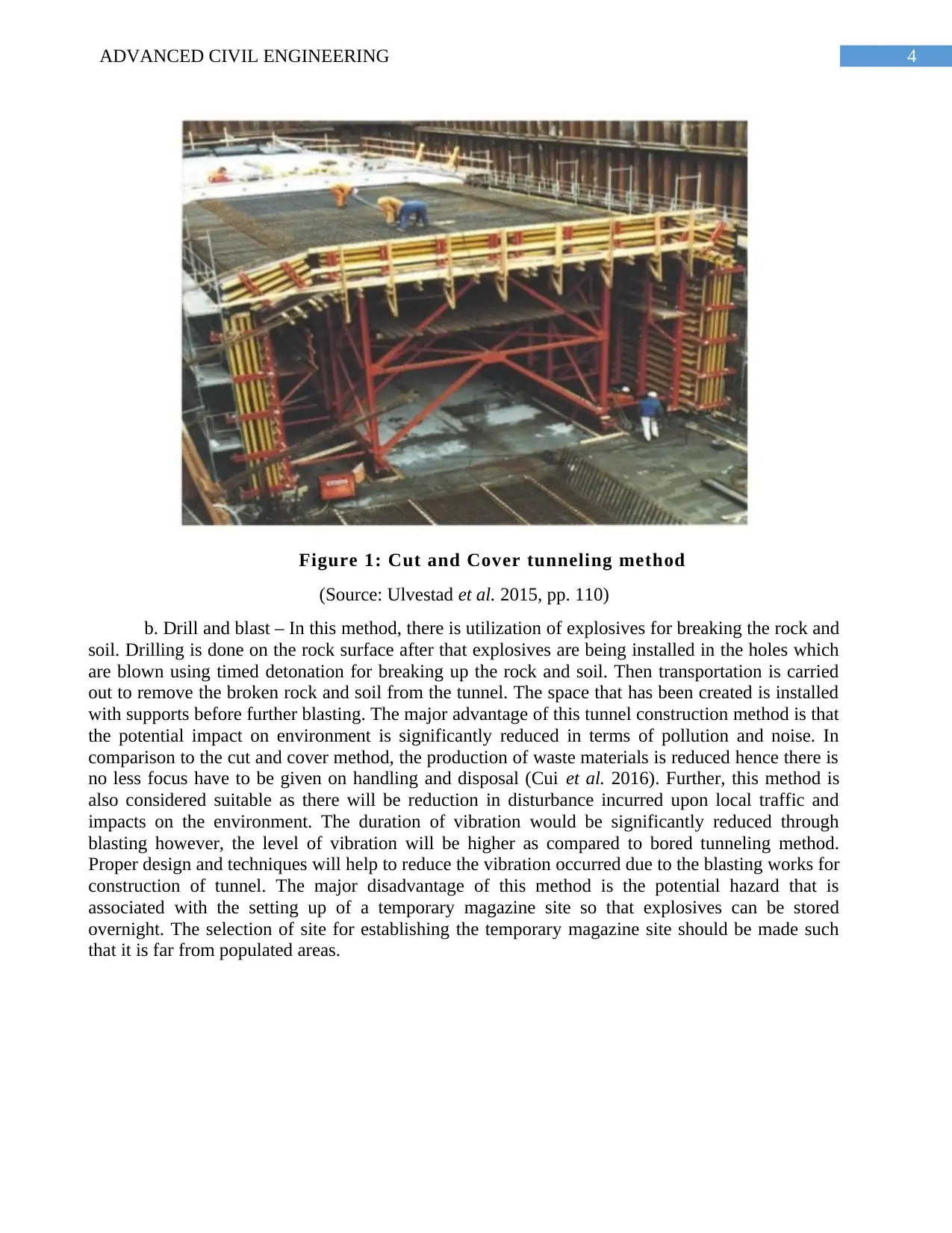
4ADVANCED CIVIL ENGINEERING
Figure 1: Cut and Cover tunneling method
(Source: Ulvestad et al. 2015, pp. 110)
b. Drill and blast – In this method, there is utilization of explosives for breaking the rock and
soil. Drilling is done on the rock surface after that explosives are being installed in the holes which
are blown using timed detonation for breaking up the rock and soil. Then transportation is carried
out to remove the broken rock and soil from the tunnel. The space that has been created is installed
with supports before further blasting. The major advantage of this tunnel construction method is that
the potential impact on environment is significantly reduced in terms of pollution and noise. In
comparison to the cut and cover method, the production of waste materials is reduced hence there is
no less focus have to be given on handling and disposal (Cui et al. 2016). Further, this method is
also considered suitable as there will be reduction in disturbance incurred upon local traffic and
impacts on the environment. The duration of vibration would be significantly reduced through
blasting however, the level of vibration will be higher as compared to bored tunneling method.
Proper design and techniques will help to reduce the vibration occurred due to the blasting works for
construction of tunnel. The major disadvantage of this method is the potential hazard that is
associated with the setting up of a temporary magazine site so that explosives can be stored
overnight. The selection of site for establishing the temporary magazine site should be made such
that it is far from populated areas.
Figure 1: Cut and Cover tunneling method
(Source: Ulvestad et al. 2015, pp. 110)
b. Drill and blast – In this method, there is utilization of explosives for breaking the rock and
soil. Drilling is done on the rock surface after that explosives are being installed in the holes which
are blown using timed detonation for breaking up the rock and soil. Then transportation is carried
out to remove the broken rock and soil from the tunnel. The space that has been created is installed
with supports before further blasting. The major advantage of this tunnel construction method is that
the potential impact on environment is significantly reduced in terms of pollution and noise. In
comparison to the cut and cover method, the production of waste materials is reduced hence there is
no less focus have to be given on handling and disposal (Cui et al. 2016). Further, this method is
also considered suitable as there will be reduction in disturbance incurred upon local traffic and
impacts on the environment. The duration of vibration would be significantly reduced through
blasting however, the level of vibration will be higher as compared to bored tunneling method.
Proper design and techniques will help to reduce the vibration occurred due to the blasting works for
construction of tunnel. The major disadvantage of this method is the potential hazard that is
associated with the setting up of a temporary magazine site so that explosives can be stored
overnight. The selection of site for establishing the temporary magazine site should be made such
that it is far from populated areas.
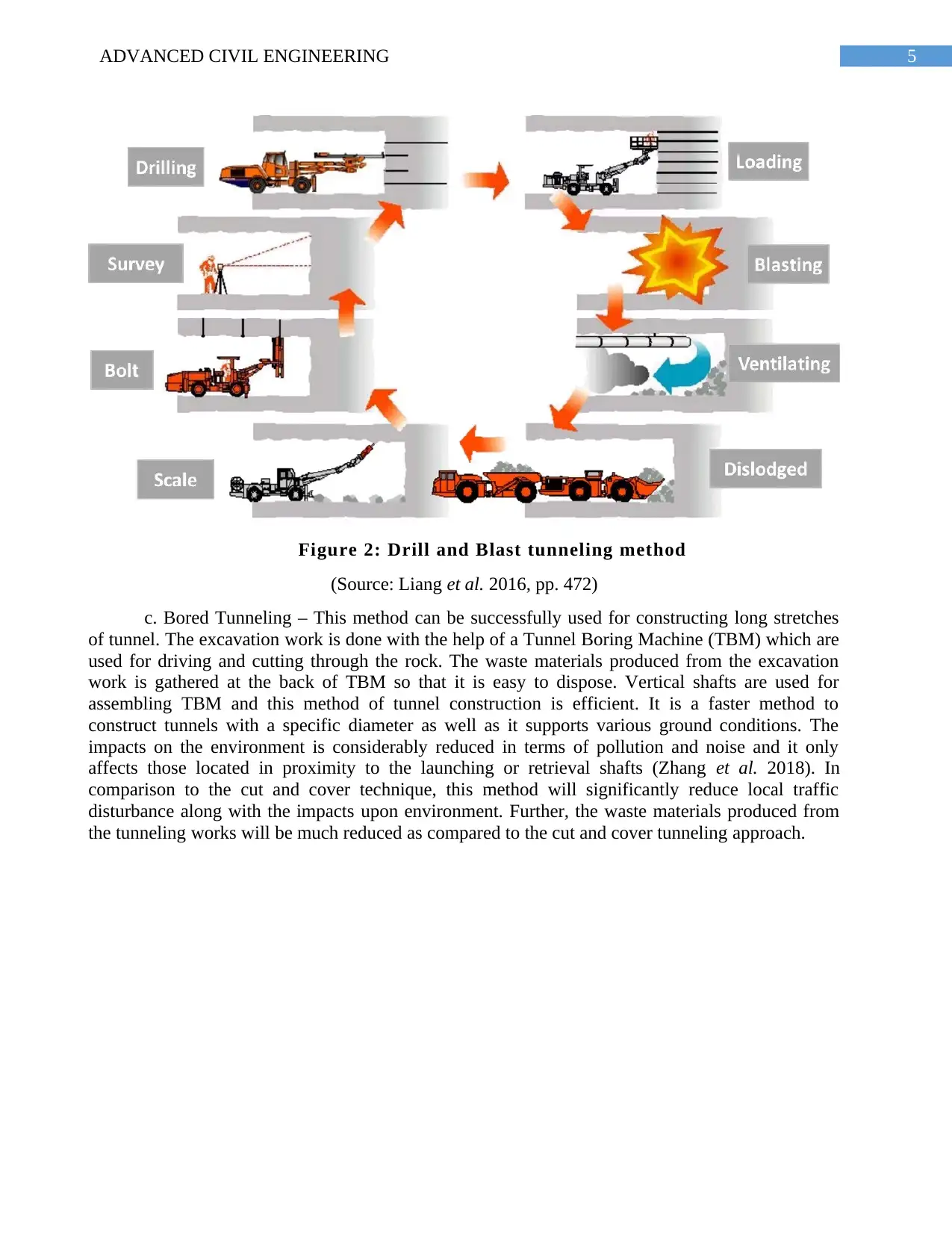
5ADVANCED CIVIL ENGINEERING
Figure 2: Drill and Blast tunneling method
(Source: Liang et al. 2016, pp. 472)
c. Bored Tunneling – This method can be successfully used for constructing long stretches
of tunnel. The excavation work is done with the help of a Tunnel Boring Machine (TBM) which are
used for driving and cutting through the rock. The waste materials produced from the excavation
work is gathered at the back of TBM so that it is easy to dispose. Vertical shafts are used for
assembling TBM and this method of tunnel construction is efficient. It is a faster method to
construct tunnels with a specific diameter as well as it supports various ground conditions. The
impacts on the environment is considerably reduced in terms of pollution and noise and it only
affects those located in proximity to the launching or retrieval shafts (Zhang et al. 2018). In
comparison to the cut and cover technique, this method will significantly reduce local traffic
disturbance along with the impacts upon environment. Further, the waste materials produced from
the tunneling works will be much reduced as compared to the cut and cover tunneling approach.
Figure 2: Drill and Blast tunneling method
(Source: Liang et al. 2016, pp. 472)
c. Bored Tunneling – This method can be successfully used for constructing long stretches
of tunnel. The excavation work is done with the help of a Tunnel Boring Machine (TBM) which are
used for driving and cutting through the rock. The waste materials produced from the excavation
work is gathered at the back of TBM so that it is easy to dispose. Vertical shafts are used for
assembling TBM and this method of tunnel construction is efficient. It is a faster method to
construct tunnels with a specific diameter as well as it supports various ground conditions. The
impacts on the environment is considerably reduced in terms of pollution and noise and it only
affects those located in proximity to the launching or retrieval shafts (Zhang et al. 2018). In
comparison to the cut and cover technique, this method will significantly reduce local traffic
disturbance along with the impacts upon environment. Further, the waste materials produced from
the tunneling works will be much reduced as compared to the cut and cover tunneling approach.
⊘ This is a preview!⊘
Do you want full access?
Subscribe today to unlock all pages.

Trusted by 1+ million students worldwide
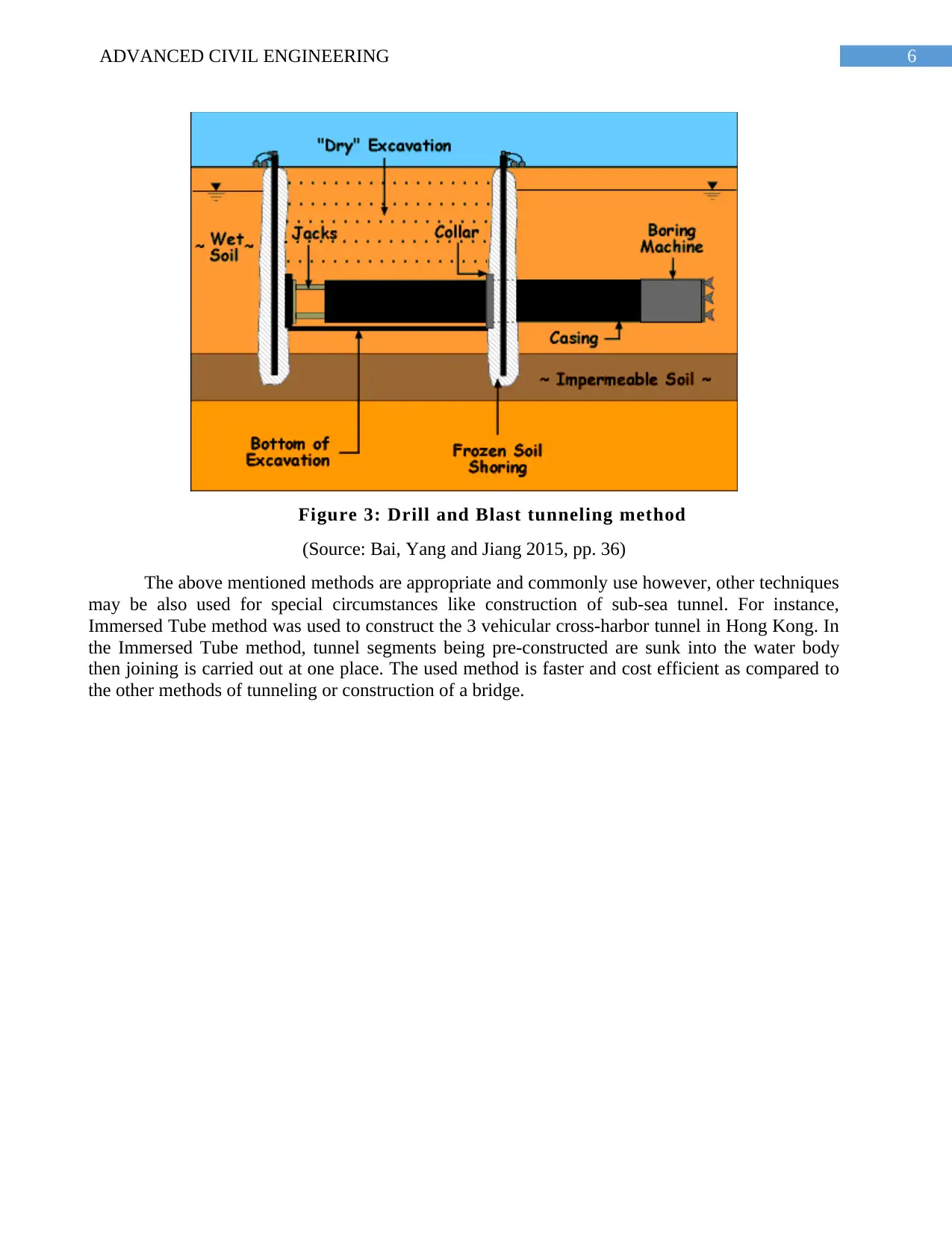
6ADVANCED CIVIL ENGINEERING
Figure 3: Drill and Blast tunneling method
(Source: Bai, Yang and Jiang 2015, pp. 36)
The above mentioned methods are appropriate and commonly use however, other techniques
may be also used for special circumstances like construction of sub-sea tunnel. For instance,
Immersed Tube method was used to construct the 3 vehicular cross-harbor tunnel in Hong Kong. In
the Immersed Tube method, tunnel segments being pre-constructed are sunk into the water body
then joining is carried out at one place. The used method is faster and cost efficient as compared to
the other methods of tunneling or construction of a bridge.
Figure 3: Drill and Blast tunneling method
(Source: Bai, Yang and Jiang 2015, pp. 36)
The above mentioned methods are appropriate and commonly use however, other techniques
may be also used for special circumstances like construction of sub-sea tunnel. For instance,
Immersed Tube method was used to construct the 3 vehicular cross-harbor tunnel in Hong Kong. In
the Immersed Tube method, tunnel segments being pre-constructed are sunk into the water body
then joining is carried out at one place. The used method is faster and cost efficient as compared to
the other methods of tunneling or construction of a bridge.
Paraphrase This Document
Need a fresh take? Get an instant paraphrase of this document with our AI Paraphraser
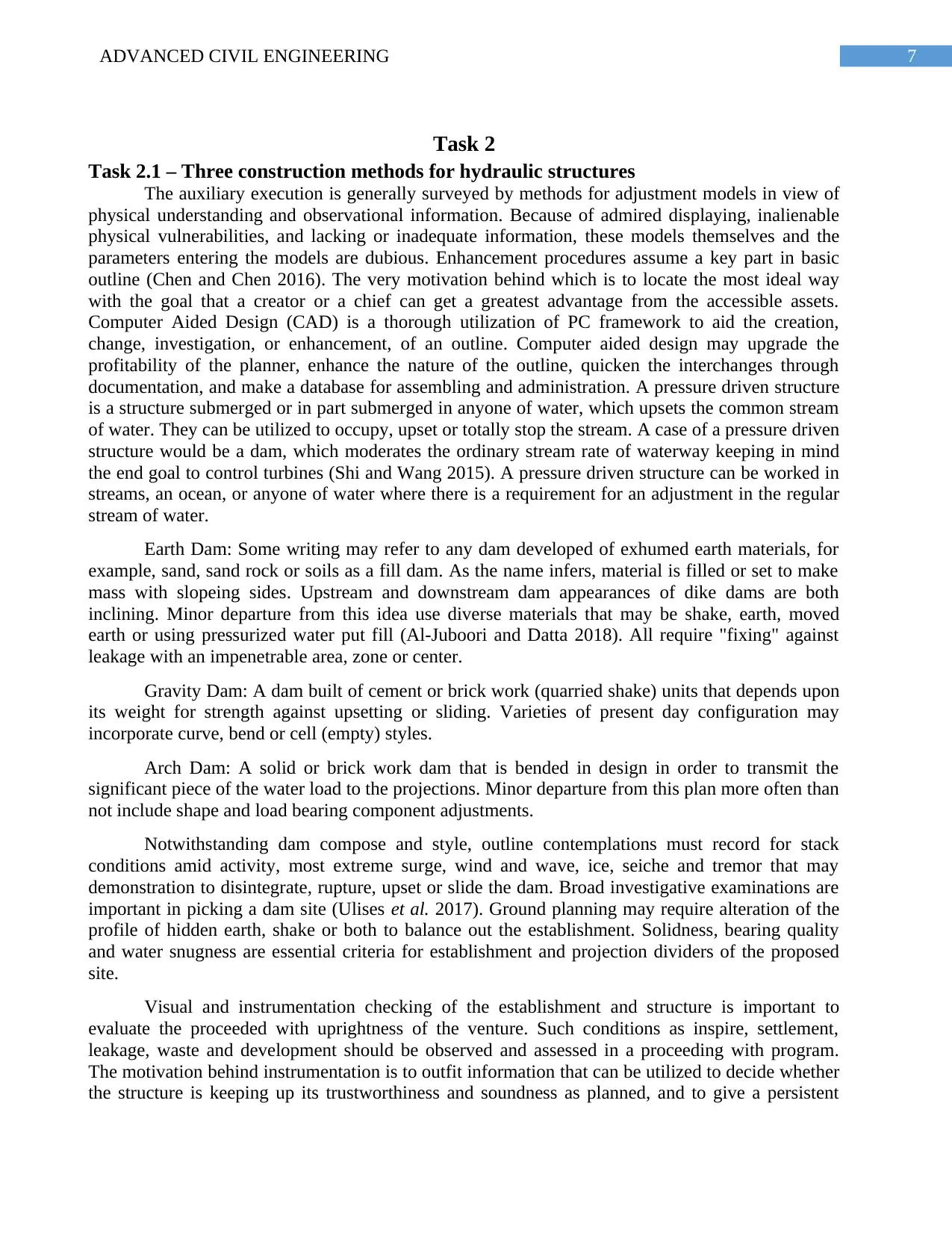
7ADVANCED CIVIL ENGINEERING
Task 2
Task 2.1 – Three construction methods for hydraulic structures
The auxiliary execution is generally surveyed by methods for adjustment models in view of
physical understanding and observational information. Because of admired displaying, inalienable
physical vulnerabilities, and lacking or inadequate information, these models themselves and the
parameters entering the models are dubious. Enhancement procedures assume a key part in basic
outline (Chen and Chen 2016). The very motivation behind which is to locate the most ideal way
with the goal that a creator or a chief can get a greatest advantage from the accessible assets.
Computer Aided Design (CAD) is a thorough utilization of PC framework to aid the creation,
change, investigation, or enhancement, of an outline. Computer aided design may upgrade the
profitability of the planner, enhance the nature of the outline, quicken the interchanges through
documentation, and make a database for assembling and administration. A pressure driven structure
is a structure submerged or in part submerged in anyone of water, which upsets the common stream
of water. They can be utilized to occupy, upset or totally stop the stream. A case of a pressure driven
structure would be a dam, which moderates the ordinary stream rate of waterway keeping in mind
the end goal to control turbines (Shi and Wang 2015). A pressure driven structure can be worked in
streams, an ocean, or anyone of water where there is a requirement for an adjustment in the regular
stream of water.
Earth Dam: Some writing may refer to any dam developed of exhumed earth materials, for
example, sand, sand rock or soils as a fill dam. As the name infers, material is filled or set to make
mass with slopeing sides. Upstream and downstream dam appearances of dike dams are both
inclining. Minor departure from this idea use diverse materials that may be shake, earth, moved
earth or using pressurized water put fill (Al-Juboori and Datta 2018). All require "fixing" against
leakage with an impenetrable area, zone or center.
Gravity Dam: A dam built of cement or brick work (quarried shake) units that depends upon
its weight for strength against upsetting or sliding. Varieties of present day configuration may
incorporate curve, bend or cell (empty) styles.
Arch Dam: A solid or brick work dam that is bended in design in order to transmit the
significant piece of the water load to the projections. Minor departure from this plan more often than
not include shape and load bearing component adjustments.
Notwithstanding dam compose and style, outline contemplations must record for stack
conditions amid activity, most extreme surge, wind and wave, ice, seiche and tremor that may
demonstration to disintegrate, rupture, upset or slide the dam. Broad investigative examinations are
important in picking a dam site (Ulises et al. 2017). Ground planning may require alteration of the
profile of hidden earth, shake or both to balance out the establishment. Solidness, bearing quality
and water snugness are essential criteria for establishment and projection dividers of the proposed
site.
Visual and instrumentation checking of the establishment and structure is important to
evaluate the proceeded with uprightness of the venture. Such conditions as inspire, settlement,
leakage, waste and development should be observed and assessed in a proceeding with program.
The motivation behind instrumentation is to outfit information that can be utilized to decide whether
the structure is keeping up its trustworthiness and soundness as planned, and to give a persistent
Task 2
Task 2.1 – Three construction methods for hydraulic structures
The auxiliary execution is generally surveyed by methods for adjustment models in view of
physical understanding and observational information. Because of admired displaying, inalienable
physical vulnerabilities, and lacking or inadequate information, these models themselves and the
parameters entering the models are dubious. Enhancement procedures assume a key part in basic
outline (Chen and Chen 2016). The very motivation behind which is to locate the most ideal way
with the goal that a creator or a chief can get a greatest advantage from the accessible assets.
Computer Aided Design (CAD) is a thorough utilization of PC framework to aid the creation,
change, investigation, or enhancement, of an outline. Computer aided design may upgrade the
profitability of the planner, enhance the nature of the outline, quicken the interchanges through
documentation, and make a database for assembling and administration. A pressure driven structure
is a structure submerged or in part submerged in anyone of water, which upsets the common stream
of water. They can be utilized to occupy, upset or totally stop the stream. A case of a pressure driven
structure would be a dam, which moderates the ordinary stream rate of waterway keeping in mind
the end goal to control turbines (Shi and Wang 2015). A pressure driven structure can be worked in
streams, an ocean, or anyone of water where there is a requirement for an adjustment in the regular
stream of water.
Earth Dam: Some writing may refer to any dam developed of exhumed earth materials, for
example, sand, sand rock or soils as a fill dam. As the name infers, material is filled or set to make
mass with slopeing sides. Upstream and downstream dam appearances of dike dams are both
inclining. Minor departure from this idea use diverse materials that may be shake, earth, moved
earth or using pressurized water put fill (Al-Juboori and Datta 2018). All require "fixing" against
leakage with an impenetrable area, zone or center.
Gravity Dam: A dam built of cement or brick work (quarried shake) units that depends upon
its weight for strength against upsetting or sliding. Varieties of present day configuration may
incorporate curve, bend or cell (empty) styles.
Arch Dam: A solid or brick work dam that is bended in design in order to transmit the
significant piece of the water load to the projections. Minor departure from this plan more often than
not include shape and load bearing component adjustments.
Notwithstanding dam compose and style, outline contemplations must record for stack
conditions amid activity, most extreme surge, wind and wave, ice, seiche and tremor that may
demonstration to disintegrate, rupture, upset or slide the dam. Broad investigative examinations are
important in picking a dam site (Ulises et al. 2017). Ground planning may require alteration of the
profile of hidden earth, shake or both to balance out the establishment. Solidness, bearing quality
and water snugness are essential criteria for establishment and projection dividers of the proposed
site.
Visual and instrumentation checking of the establishment and structure is important to
evaluate the proceeded with uprightness of the venture. Such conditions as inspire, settlement,
leakage, waste and development should be observed and assessed in a proceeding with program.
The motivation behind instrumentation is to outfit information that can be utilized to decide whether
the structure is keeping up its trustworthiness and soundness as planned, and to give a persistent
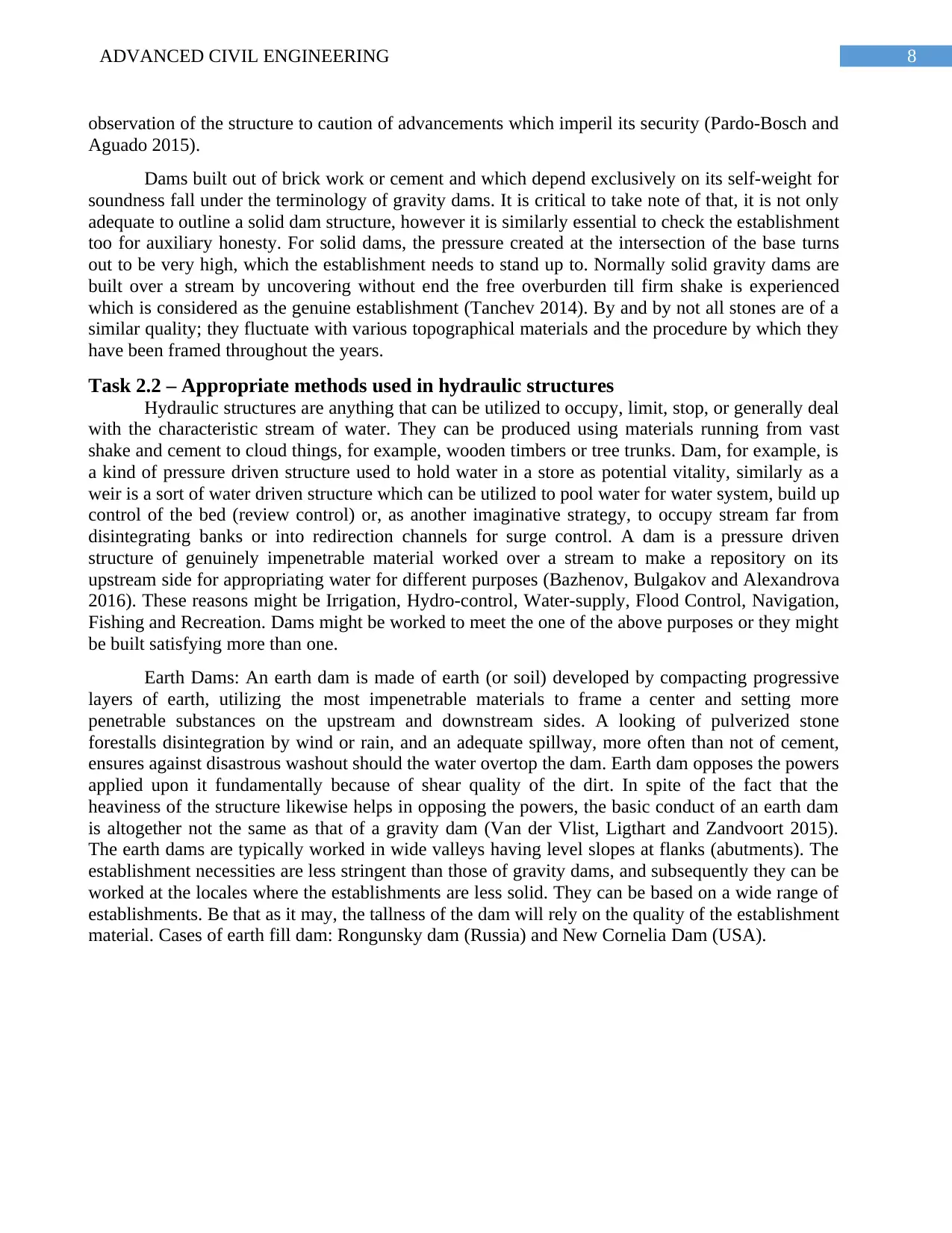
8ADVANCED CIVIL ENGINEERING
observation of the structure to caution of advancements which imperil its security (Pardo-Bosch and
Aguado 2015).
Dams built out of brick work or cement and which depend exclusively on its self-weight for
soundness fall under the terminology of gravity dams. It is critical to take note of that, it is not only
adequate to outline a solid dam structure, however it is similarly essential to check the establishment
too for auxiliary honesty. For solid dams, the pressure created at the intersection of the base turns
out to be very high, which the establishment needs to stand up to. Normally solid gravity dams are
built over a stream by uncovering without end the free overburden till firm shake is experienced
which is considered as the genuine establishment (Tanchev 2014). By and by not all stones are of a
similar quality; they fluctuate with various topographical materials and the procedure by which they
have been framed throughout the years.
Task 2.2 – Appropriate methods used in hydraulic structures
Hydraulic structures are anything that can be utilized to occupy, limit, stop, or generally deal
with the characteristic stream of water. They can be produced using materials running from vast
shake and cement to cloud things, for example, wooden timbers or tree trunks. Dam, for example, is
a kind of pressure driven structure used to hold water in a store as potential vitality, similarly as a
weir is a sort of water driven structure which can be utilized to pool water for water system, build up
control of the bed (review control) or, as another imaginative strategy, to occupy stream far from
disintegrating banks or into redirection channels for surge control. A dam is a pressure driven
structure of genuinely impenetrable material worked over a stream to make a repository on its
upstream side for appropriating water for different purposes (Bazhenov, Bulgakov and Alexandrova
2016). These reasons might be Irrigation, Hydro-control, Water-supply, Flood Control, Navigation,
Fishing and Recreation. Dams might be worked to meet the one of the above purposes or they might
be built satisfying more than one.
Earth Dams: An earth dam is made of earth (or soil) developed by compacting progressive
layers of earth, utilizing the most impenetrable materials to frame a center and setting more
penetrable substances on the upstream and downstream sides. A looking of pulverized stone
forestalls disintegration by wind or rain, and an adequate spillway, more often than not of cement,
ensures against disastrous washout should the water overtop the dam. Earth dam opposes the powers
applied upon it fundamentally because of shear quality of the dirt. In spite of the fact that the
heaviness of the structure likewise helps in opposing the powers, the basic conduct of an earth dam
is altogether not the same as that of a gravity dam (Van der Vlist, Ligthart and Zandvoort 2015).
The earth dams are typically worked in wide valleys having level slopes at flanks (abutments). The
establishment necessities are less stringent than those of gravity dams, and subsequently they can be
worked at the locales where the establishments are less solid. They can be based on a wide range of
establishments. Be that as it may, the tallness of the dam will rely on the quality of the establishment
material. Cases of earth fill dam: Rongunsky dam (Russia) and New Cornelia Dam (USA).
observation of the structure to caution of advancements which imperil its security (Pardo-Bosch and
Aguado 2015).
Dams built out of brick work or cement and which depend exclusively on its self-weight for
soundness fall under the terminology of gravity dams. It is critical to take note of that, it is not only
adequate to outline a solid dam structure, however it is similarly essential to check the establishment
too for auxiliary honesty. For solid dams, the pressure created at the intersection of the base turns
out to be very high, which the establishment needs to stand up to. Normally solid gravity dams are
built over a stream by uncovering without end the free overburden till firm shake is experienced
which is considered as the genuine establishment (Tanchev 2014). By and by not all stones are of a
similar quality; they fluctuate with various topographical materials and the procedure by which they
have been framed throughout the years.
Task 2.2 – Appropriate methods used in hydraulic structures
Hydraulic structures are anything that can be utilized to occupy, limit, stop, or generally deal
with the characteristic stream of water. They can be produced using materials running from vast
shake and cement to cloud things, for example, wooden timbers or tree trunks. Dam, for example, is
a kind of pressure driven structure used to hold water in a store as potential vitality, similarly as a
weir is a sort of water driven structure which can be utilized to pool water for water system, build up
control of the bed (review control) or, as another imaginative strategy, to occupy stream far from
disintegrating banks or into redirection channels for surge control. A dam is a pressure driven
structure of genuinely impenetrable material worked over a stream to make a repository on its
upstream side for appropriating water for different purposes (Bazhenov, Bulgakov and Alexandrova
2016). These reasons might be Irrigation, Hydro-control, Water-supply, Flood Control, Navigation,
Fishing and Recreation. Dams might be worked to meet the one of the above purposes or they might
be built satisfying more than one.
Earth Dams: An earth dam is made of earth (or soil) developed by compacting progressive
layers of earth, utilizing the most impenetrable materials to frame a center and setting more
penetrable substances on the upstream and downstream sides. A looking of pulverized stone
forestalls disintegration by wind or rain, and an adequate spillway, more often than not of cement,
ensures against disastrous washout should the water overtop the dam. Earth dam opposes the powers
applied upon it fundamentally because of shear quality of the dirt. In spite of the fact that the
heaviness of the structure likewise helps in opposing the powers, the basic conduct of an earth dam
is altogether not the same as that of a gravity dam (Van der Vlist, Ligthart and Zandvoort 2015).
The earth dams are typically worked in wide valleys having level slopes at flanks (abutments). The
establishment necessities are less stringent than those of gravity dams, and subsequently they can be
worked at the locales where the establishments are less solid. They can be based on a wide range of
establishments. Be that as it may, the tallness of the dam will rely on the quality of the establishment
material. Cases of earth fill dam: Rongunsky dam (Russia) and New Cornelia Dam (USA).
⊘ This is a preview!⊘
Do you want full access?
Subscribe today to unlock all pages.

Trusted by 1+ million students worldwide
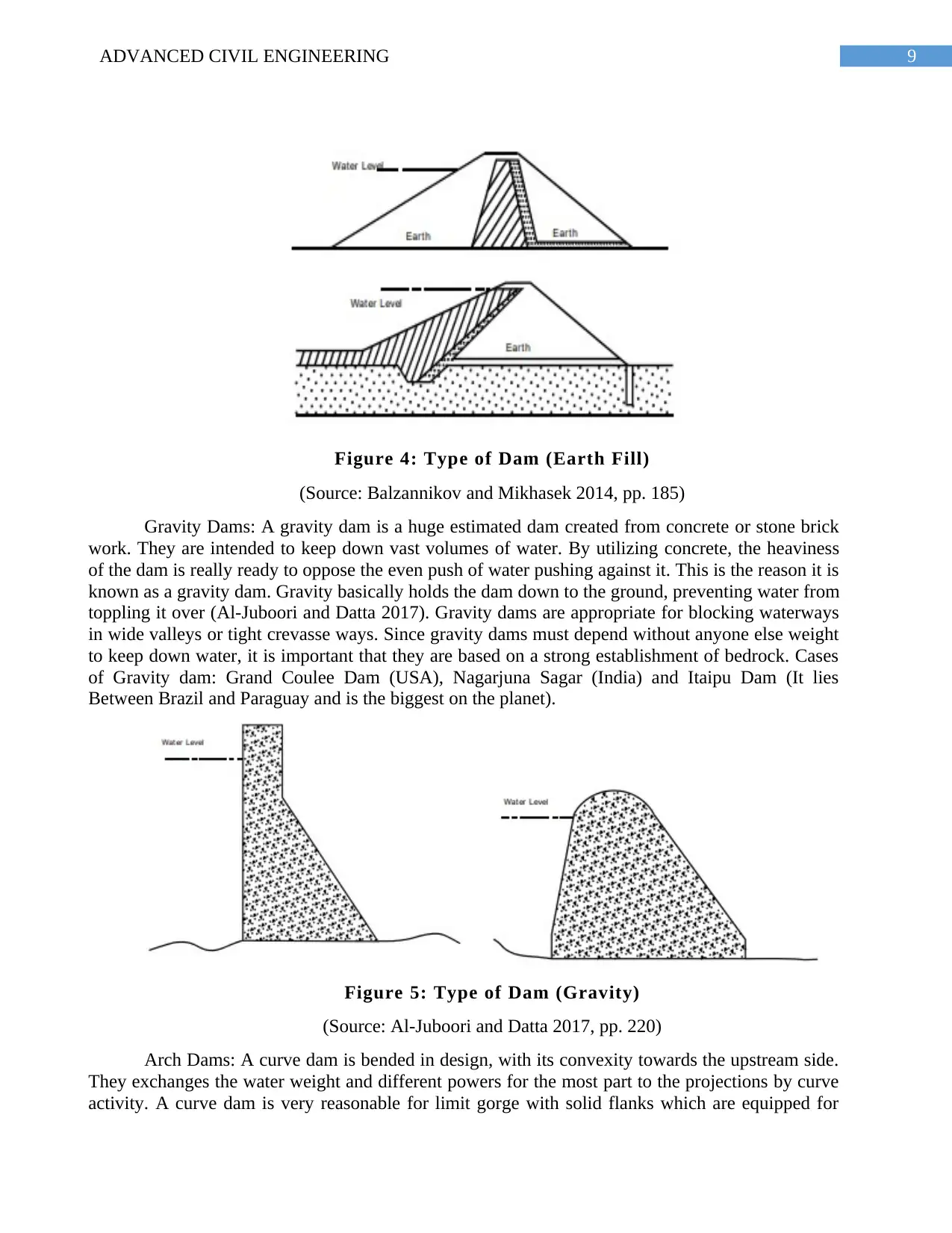
9ADVANCED CIVIL ENGINEERING
Figure 4: Type of Dam (Earth Fill)
(Source: Balzannikov and Mikhasek 2014, pp. 185)
Gravity Dams: A gravity dam is a huge estimated dam created from concrete or stone brick
work. They are intended to keep down vast volumes of water. By utilizing concrete, the heaviness
of the dam is really ready to oppose the even push of water pushing against it. This is the reason it is
known as a gravity dam. Gravity basically holds the dam down to the ground, preventing water from
toppling it over (Al-Juboori and Datta 2017). Gravity dams are appropriate for blocking waterways
in wide valleys or tight crevasse ways. Since gravity dams must depend without anyone else weight
to keep down water, it is important that they are based on a strong establishment of bedrock. Cases
of Gravity dam: Grand Coulee Dam (USA), Nagarjuna Sagar (India) and Itaipu Dam (It lies
Between Brazil and Paraguay and is the biggest on the planet).
Figure 5: Type of Dam (Gravity)
(Source: Al-Juboori and Datta 2017, pp. 220)
Arch Dams: A curve dam is bended in design, with its convexity towards the upstream side.
They exchanges the water weight and different powers for the most part to the projections by curve
activity. A curve dam is very reasonable for limit gorge with solid flanks which are equipped for
Figure 4: Type of Dam (Earth Fill)
(Source: Balzannikov and Mikhasek 2014, pp. 185)
Gravity Dams: A gravity dam is a huge estimated dam created from concrete or stone brick
work. They are intended to keep down vast volumes of water. By utilizing concrete, the heaviness
of the dam is really ready to oppose the even push of water pushing against it. This is the reason it is
known as a gravity dam. Gravity basically holds the dam down to the ground, preventing water from
toppling it over (Al-Juboori and Datta 2017). Gravity dams are appropriate for blocking waterways
in wide valleys or tight crevasse ways. Since gravity dams must depend without anyone else weight
to keep down water, it is important that they are based on a strong establishment of bedrock. Cases
of Gravity dam: Grand Coulee Dam (USA), Nagarjuna Sagar (India) and Itaipu Dam (It lies
Between Brazil and Paraguay and is the biggest on the planet).
Figure 5: Type of Dam (Gravity)
(Source: Al-Juboori and Datta 2017, pp. 220)
Arch Dams: A curve dam is bended in design, with its convexity towards the upstream side.
They exchanges the water weight and different powers for the most part to the projections by curve
activity. A curve dam is very reasonable for limit gorge with solid flanks which are equipped for
Paraphrase This Document
Need a fresh take? Get an instant paraphrase of this document with our AI Paraphraser
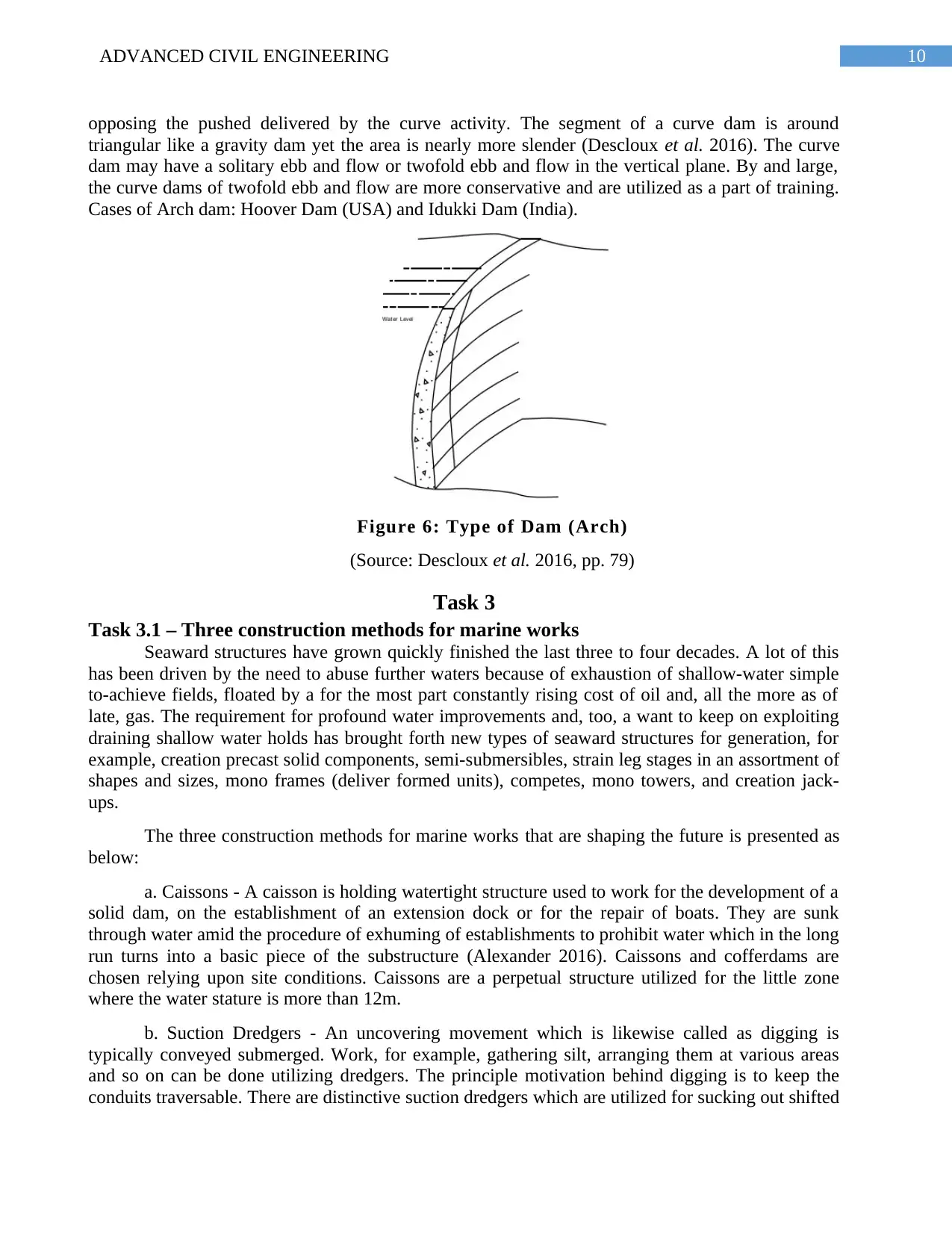
10ADVANCED CIVIL ENGINEERING
opposing the pushed delivered by the curve activity. The segment of a curve dam is around
triangular like a gravity dam yet the area is nearly more slender (Descloux et al. 2016). The curve
dam may have a solitary ebb and flow or twofold ebb and flow in the vertical plane. By and large,
the curve dams of twofold ebb and flow are more conservative and are utilized as a part of training.
Cases of Arch dam: Hoover Dam (USA) and Idukki Dam (India).
Figure 6: Type of Dam (Arch)
(Source: Descloux et al. 2016, pp. 79)
Task 3
Task 3.1 – Three construction methods for marine works
Seaward structures have grown quickly finished the last three to four decades. A lot of this
has been driven by the need to abuse further waters because of exhaustion of shallow-water simple
to-achieve fields, floated by a for the most part constantly rising cost of oil and, all the more as of
late, gas. The requirement for profound water improvements and, too, a want to keep on exploiting
draining shallow water holds has brought forth new types of seaward structures for generation, for
example, creation precast solid components, semi-submersibles, strain leg stages in an assortment of
shapes and sizes, mono frames (deliver formed units), competes, mono towers, and creation jack-
ups.
The three construction methods for marine works that are shaping the future is presented as
below:
a. Caissons - A caisson is holding watertight structure used to work for the development of a
solid dam, on the establishment of an extension dock or for the repair of boats. They are sunk
through water amid the procedure of exhuming of establishments to prohibit water which in the long
run turns into a basic piece of the substructure (Alexander 2016). Caissons and cofferdams are
chosen relying upon site conditions. Caissons are a perpetual structure utilized for the little zone
where the water stature is more than 12m.
b. Suction Dredgers - An uncovering movement which is likewise called as digging is
typically conveyed submerged. Work, for example, gathering silt, arranging them at various areas
and so on can be done utilizing dredgers. The principle motivation behind digging is to keep the
conduits traversable. There are distinctive suction dredgers which are utilized for sucking out shifted
opposing the pushed delivered by the curve activity. The segment of a curve dam is around
triangular like a gravity dam yet the area is nearly more slender (Descloux et al. 2016). The curve
dam may have a solitary ebb and flow or twofold ebb and flow in the vertical plane. By and large,
the curve dams of twofold ebb and flow are more conservative and are utilized as a part of training.
Cases of Arch dam: Hoover Dam (USA) and Idukki Dam (India).
Figure 6: Type of Dam (Arch)
(Source: Descloux et al. 2016, pp. 79)
Task 3
Task 3.1 – Three construction methods for marine works
Seaward structures have grown quickly finished the last three to four decades. A lot of this
has been driven by the need to abuse further waters because of exhaustion of shallow-water simple
to-achieve fields, floated by a for the most part constantly rising cost of oil and, all the more as of
late, gas. The requirement for profound water improvements and, too, a want to keep on exploiting
draining shallow water holds has brought forth new types of seaward structures for generation, for
example, creation precast solid components, semi-submersibles, strain leg stages in an assortment of
shapes and sizes, mono frames (deliver formed units), competes, mono towers, and creation jack-
ups.
The three construction methods for marine works that are shaping the future is presented as
below:
a. Caissons - A caisson is holding watertight structure used to work for the development of a
solid dam, on the establishment of an extension dock or for the repair of boats. They are sunk
through water amid the procedure of exhuming of establishments to prohibit water which in the long
run turns into a basic piece of the substructure (Alexander 2016). Caissons and cofferdams are
chosen relying upon site conditions. Caissons are a perpetual structure utilized for the little zone
where the water stature is more than 12m.
b. Suction Dredgers - An uncovering movement which is likewise called as digging is
typically conveyed submerged. Work, for example, gathering silt, arranging them at various areas
and so on can be done utilizing dredgers. The principle motivation behind digging is to keep the
conduits traversable. There are distinctive suction dredgers which are utilized for sucking out shifted
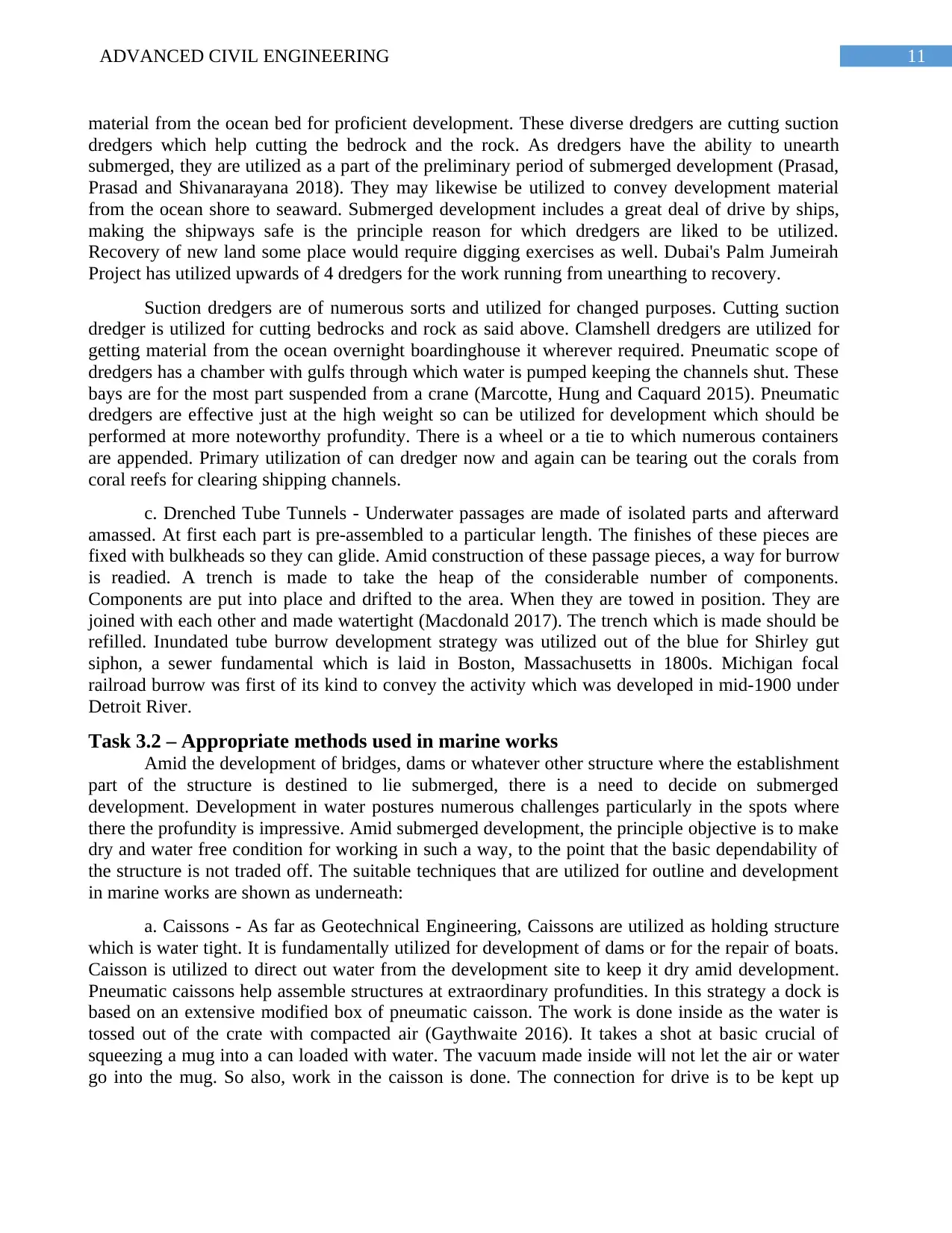
11ADVANCED CIVIL ENGINEERING
material from the ocean bed for proficient development. These diverse dredgers are cutting suction
dredgers which help cutting the bedrock and the rock. As dredgers have the ability to unearth
submerged, they are utilized as a part of the preliminary period of submerged development (Prasad,
Prasad and Shivanarayana 2018). They may likewise be utilized to convey development material
from the ocean shore to seaward. Submerged development includes a great deal of drive by ships,
making the shipways safe is the principle reason for which dredgers are liked to be utilized.
Recovery of new land some place would require digging exercises as well. Dubai's Palm Jumeirah
Project has utilized upwards of 4 dredgers for the work running from unearthing to recovery.
Suction dredgers are of numerous sorts and utilized for changed purposes. Cutting suction
dredger is utilized for cutting bedrocks and rock as said above. Clamshell dredgers are utilized for
getting material from the ocean overnight boardinghouse it wherever required. Pneumatic scope of
dredgers has a chamber with gulfs through which water is pumped keeping the channels shut. These
bays are for the most part suspended from a crane (Marcotte, Hung and Caquard 2015). Pneumatic
dredgers are effective just at the high weight so can be utilized for development which should be
performed at more noteworthy profundity. There is a wheel or a tie to which numerous containers
are appended. Primary utilization of can dredger now and again can be tearing out the corals from
coral reefs for clearing shipping channels.
c. Drenched Tube Tunnels - Underwater passages are made of isolated parts and afterward
amassed. At first each part is pre-assembled to a particular length. The finishes of these pieces are
fixed with bulkheads so they can glide. Amid construction of these passage pieces, a way for burrow
is readied. A trench is made to take the heap of the considerable number of components.
Components are put into place and drifted to the area. When they are towed in position. They are
joined with each other and made watertight (Macdonald 2017). The trench which is made should be
refilled. Inundated tube burrow development strategy was utilized out of the blue for Shirley gut
siphon, a sewer fundamental which is laid in Boston, Massachusetts in 1800s. Michigan focal
railroad burrow was first of its kind to convey the activity which was developed in mid-1900 under
Detroit River.
Task 3.2 – Appropriate methods used in marine works
Amid the development of bridges, dams or whatever other structure where the establishment
part of the structure is destined to lie submerged, there is a need to decide on submerged
development. Development in water postures numerous challenges particularly in the spots where
there the profundity is impressive. Amid submerged development, the principle objective is to make
dry and water free condition for working in such a way, to the point that the basic dependability of
the structure is not traded off. The suitable techniques that are utilized for outline and development
in marine works are shown as underneath:
a. Caissons - As far as Geotechnical Engineering, Caissons are utilized as holding structure
which is water tight. It is fundamentally utilized for development of dams or for the repair of boats.
Caisson is utilized to direct out water from the development site to keep it dry amid development.
Pneumatic caissons help assemble structures at extraordinary profundities. In this strategy a dock is
based on an extensive modified box of pneumatic caisson. The work is done inside as the water is
tossed out of the crate with compacted air (Gaythwaite 2016). It takes a shot at basic crucial of
squeezing a mug into a can loaded with water. The vacuum made inside will not let the air or water
go into the mug. So also, work in the caisson is done. The connection for drive is to be kept up
material from the ocean bed for proficient development. These diverse dredgers are cutting suction
dredgers which help cutting the bedrock and the rock. As dredgers have the ability to unearth
submerged, they are utilized as a part of the preliminary period of submerged development (Prasad,
Prasad and Shivanarayana 2018). They may likewise be utilized to convey development material
from the ocean shore to seaward. Submerged development includes a great deal of drive by ships,
making the shipways safe is the principle reason for which dredgers are liked to be utilized.
Recovery of new land some place would require digging exercises as well. Dubai's Palm Jumeirah
Project has utilized upwards of 4 dredgers for the work running from unearthing to recovery.
Suction dredgers are of numerous sorts and utilized for changed purposes. Cutting suction
dredger is utilized for cutting bedrocks and rock as said above. Clamshell dredgers are utilized for
getting material from the ocean overnight boardinghouse it wherever required. Pneumatic scope of
dredgers has a chamber with gulfs through which water is pumped keeping the channels shut. These
bays are for the most part suspended from a crane (Marcotte, Hung and Caquard 2015). Pneumatic
dredgers are effective just at the high weight so can be utilized for development which should be
performed at more noteworthy profundity. There is a wheel or a tie to which numerous containers
are appended. Primary utilization of can dredger now and again can be tearing out the corals from
coral reefs for clearing shipping channels.
c. Drenched Tube Tunnels - Underwater passages are made of isolated parts and afterward
amassed. At first each part is pre-assembled to a particular length. The finishes of these pieces are
fixed with bulkheads so they can glide. Amid construction of these passage pieces, a way for burrow
is readied. A trench is made to take the heap of the considerable number of components.
Components are put into place and drifted to the area. When they are towed in position. They are
joined with each other and made watertight (Macdonald 2017). The trench which is made should be
refilled. Inundated tube burrow development strategy was utilized out of the blue for Shirley gut
siphon, a sewer fundamental which is laid in Boston, Massachusetts in 1800s. Michigan focal
railroad burrow was first of its kind to convey the activity which was developed in mid-1900 under
Detroit River.
Task 3.2 – Appropriate methods used in marine works
Amid the development of bridges, dams or whatever other structure where the establishment
part of the structure is destined to lie submerged, there is a need to decide on submerged
development. Development in water postures numerous challenges particularly in the spots where
there the profundity is impressive. Amid submerged development, the principle objective is to make
dry and water free condition for working in such a way, to the point that the basic dependability of
the structure is not traded off. The suitable techniques that are utilized for outline and development
in marine works are shown as underneath:
a. Caissons - As far as Geotechnical Engineering, Caissons are utilized as holding structure
which is water tight. It is fundamentally utilized for development of dams or for the repair of boats.
Caisson is utilized to direct out water from the development site to keep it dry amid development.
Pneumatic caissons help assemble structures at extraordinary profundities. In this strategy a dock is
based on an extensive modified box of pneumatic caisson. The work is done inside as the water is
tossed out of the crate with compacted air (Gaythwaite 2016). It takes a shot at basic crucial of
squeezing a mug into a can loaded with water. The vacuum made inside will not let the air or water
go into the mug. So also, work in the caisson is done. The connection for drive is to be kept up
⊘ This is a preview!⊘
Do you want full access?
Subscribe today to unlock all pages.

Trusted by 1+ million students worldwide
1 out of 27
Related Documents
Your All-in-One AI-Powered Toolkit for Academic Success.
+13062052269
info@desklib.com
Available 24*7 on WhatsApp / Email
![[object Object]](/_next/static/media/star-bottom.7253800d.svg)
Unlock your academic potential
Copyright © 2020–2025 A2Z Services. All Rights Reserved. Developed and managed by ZUCOL.




